The secrets behind the Surface Studio design

Microsoft’s getting quite good at design moonshots, creating product silhouettes that challenge our notions of what computing should look like. The large, yet astonishingly thin, Surface Studio is a perfect reflection of that still somewhat new skill.
As I looked over that all-in-one Windows 10 computer and a slightly updated Surface Book beside it in Microsoft’s pop-up product experience room adjacent to the hall where Microsoft Device lead Panos Panay had just introduced the new hardware, I realized I had myriad questions about both, but mostly about the Surface Studio.

Image: LILI SAMS/MASHABLE
I glanced away from the 28-inch glowing Studio display and spotted a familiar face. Ralf Groene, Microsoft’s head of industrial design, was standing alone, staring almost wistfully into space. The last time I’d seen Groene was almost a year ago and he was showing me two stuck-together pieces of black cardboard, the rough-hewn seedling for the product idea that would become the Surface Book.
Groene smiled broadly when I approached him. He seemed to remember me, so I quickly began peppering him with questions on the new and updated products.
Surface Studio design decisions
“We couldn’t prototype this with Scotch tape,” Groene told me, laughing as he gestured to the Surface Studio.
No, to work on something of this size they had to take a different approach, which ultimately led the design team to laser-cutting a bunch of plastic sheets and stacking them on top of each other. This was how Microsoft came up with the basic design for the all-in-one PC that is probably 90 percent screen, with a pair of chrome arms attached to an incredibly small base that houses the CPU.

Image: lance ulanoff/mashable
Groene also made it clear that the Surface Studio was designed from the get-go with creators in mind. Having a drafting mode was critical. The 20-degree-max screen-tilt angle is no accident. Groene said that angle is the standard for drafting boards. But it’s about more than just the angle of the Studio’s creation plane.
Artists and designers, Groene told me (speaking from experience, obviously), are always sketching half-formed ideas on whiteboards, napkins and moleskin notebooks. The idea, with Surface Studio is to cut out that half step. Let the ideas form on the screen in draft mode and then shift the screen upright, step back and look at the work.
“There is this notion of sketching an idea and stepping back and reviewing it,” he said.

Image: LILI SAMS/MASHABLE
The only way to encourage that interaction, though, is to make it obvious and effortless. The Surface Studio appears to accomplish that goal. In addition to an intricately designed hinge system that’s hidden in the Surface’s chrome arms (there’s actually a seam along the edge of the chrome support), Groene noted that you needed a good base to allow the 13 pound, 12.5 mm-thick screen to move smoothly.
“We wanted it to be a floating sheet of pixels,” Groene told me.
Then he pointed out something a little subtle, but perhaps no less important: the feet under the Surface Studio’s box-shaped main computer are a special plastic that is designed to keep the system in place on your desk when you adjust the screen, but also allow it to move easily when you want it to. I could see this in action. Whenever I adjusted the screen, the system base never moved, but I could also easily grab both sides of the large screen and turn the whole computer without feeling like I was dragging the system across the table.
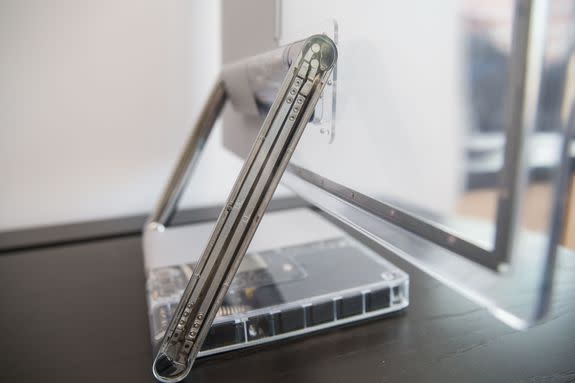
Image: LILI SAMS/MASHABLE
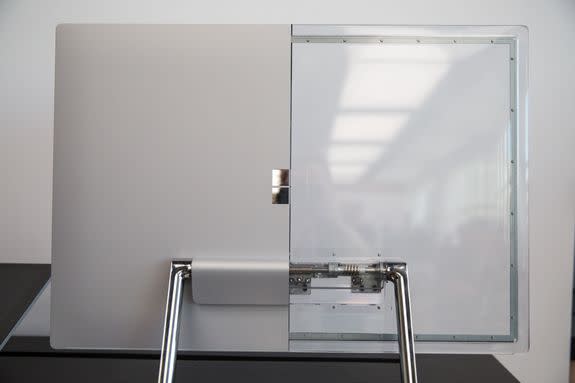
Image: LILI SAMS/MASHABLE
As we talked, I kept commenting on the size of the screen. The Surface Studio can fit four 14-inch screens inside its one. “Was this always the target size,” I asked Groene. Not by a long shot. Groene said they had 20-to-30 mock-ups of varying sizes and aspect ratios, including 24- and 27 inches and 16:9 and 16:10 aspect ratio screens.
Ultimately, Microsoft arrived at 28 inches, which Groene said “looks phenomenal” and a 3:2 aspect ratio, which gives the user substantially more space at the base of the screen than they might have gotten with a shallower 16:9 screen. Groene told me the deeper screen leaves ample room for, say, application tools at the base of the screen.
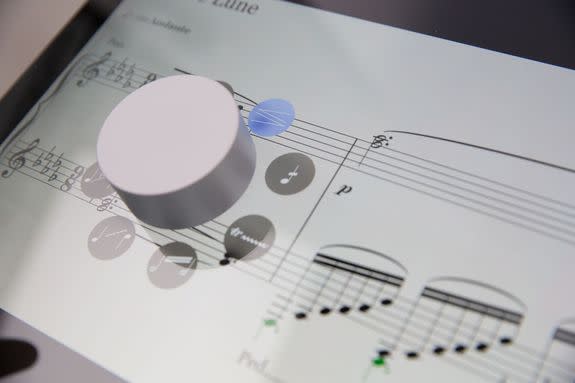
Image: LILI SAMS/MASHABLE
We also talked briefly about the optional (and unusual) Surface Dial, which can be used beside the Surface Studio or placed on top of the screen. To explain why such a tactile device makes sense with a large touch-screen computer like the Surface Studio, Groene pointed to the Tesla. It has a wonderful large screen in the center, eschewing many of the sliders, buttons and knobs found in traditional cars, “but they have the steering wheel which is nice and super tactile,” he smiled.
I took this to mean that the Surface Dial, with its haptic feedback, is the Surface Studio’s tiny steering wheel.
Surface Book changes
Next to the gleaming Surface Studio sat the matte-finish Surface Book (version 2). It looks almost exactly like the clipboard PC I first encountered almost a year ago, but with one noticeable change. The keyboard now slopes down from back to front; not a lot, but enough that the back edge of the Surface Book base is now thicker than the front (the area that houses the touchpad).
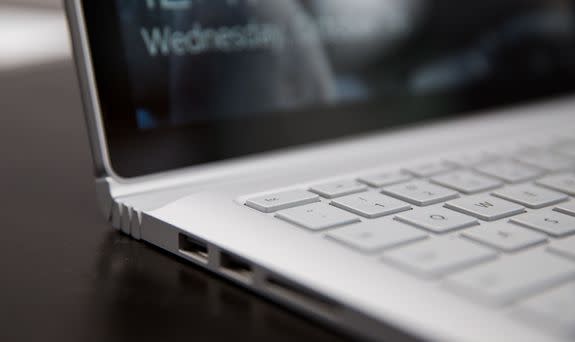
Image: LILI SAMS/MASHABLE
Groene acknowledges the change, which slightly fills in the gap left by the fulcrum hinge design when you close the Surface Book. He told me that none of the keys have moved, nor has the keyboard been redesigned. The angle change on the keyboard “is so minuscule you will not notice,” he insisted. Maybe, but when you look at the laptop from the side you can now see that the keyboard is no longer on a flat plane.
The change, Groene told me, is not an aesthetic one. Instead, it was all done to accommodate more batteries and, more importantly, a new thermal system, which was necessary for the more powerful NVidia GPU that lives in the base (the CPU lives in the screen).
Groene explained that the change started with the component upgrade decision. He said they always wanted to add more batteries (the laptop now promises, according to Microsoft, 16 hours on a charge). The key, he noted, was to find a “balance point, a change in some minimal way to allow this.”
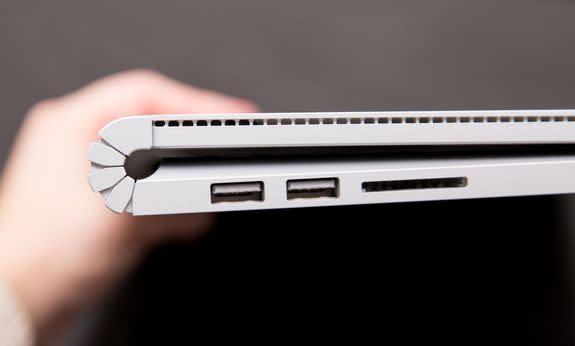
Image: LILI SAMS/MASHABLE
Microsoft did have to do some pretty intense engineering to create a new thermal system or envelope that would accommodate the new GPU in a form-factor that worked within the broader Surface Book framework. Groene said they developed a new hyperbolic fan blade that creates a special kind of airflow and, even then, it required multiple 3D print prototypes to get it right.
Basically, they were “reengineering the whole bottom case. Not from a design perspective, but for more power,” he said.
With that, I thanked Groene for his time and then watched as he quietly blended back into the crowd of Microsoft staffers and journalists busily appraising Microsoft's (and his) latest creation.

 Yahoo News
Yahoo News 